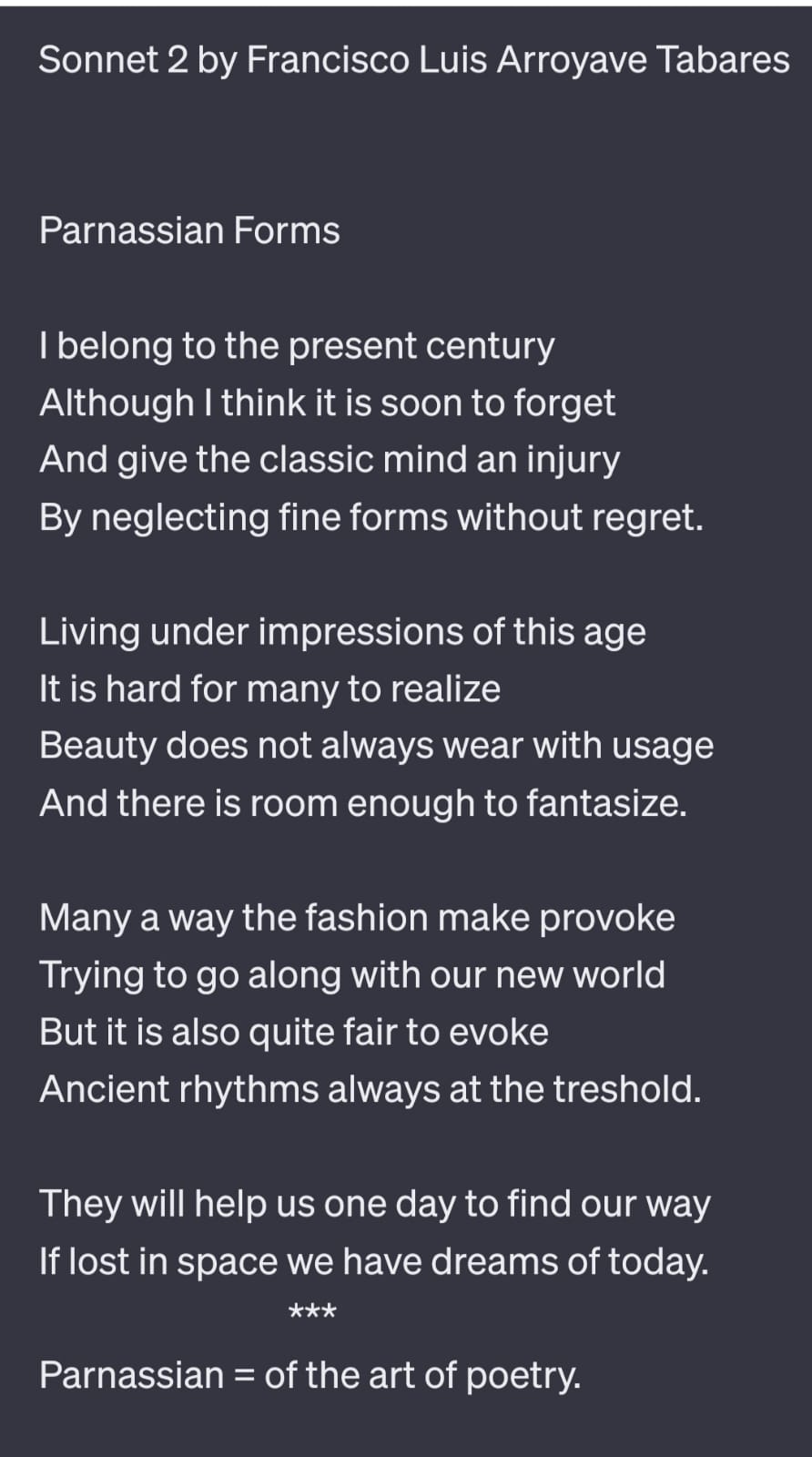-
 @ Francisco Luis
2023-12-02 04:11:02
@ Francisco Luis
2023-12-02 04:11:02Posthumous work of the Colombian poet born in Don Matias on January 20, 1948.
Welcome to this blog dedicated to the Posthumous work of the Colombian poet Francisco Luis Arroyave Tabares (my father), born in Don Matias on January 20, 1948-2010. Where I will be publishing each of the 175 sonnets from his unpublished collection 'Sonnets For The Twenty-First Century And A Circadian Musical (1984-1987).' Analyzed with GPT4 artificial intelligence and illustrated with AI tools... I hope you enjoy this garden of words snatched from the solitude of a locked room.
Likewise, any enthusiast of the sonnet form is invited to conduct their personal studies of Arroyave Tabares' work, as it is a collection that, although registered since 1989, has not yet been published.
Frank Duna

Analysis "Parnassian Forms"
Introduction
Sonnet 2 by Francisco Luis Arroyave Tabares is a reflection on the tension between the modern world and the classical traditions of poetry.
Thematic Analysis
Quatrain 1: The speaker describes how music brings forth emotions and memories, filling the void left by lost innocence. This suggests a sense of nostalgia and longing for simpler times.
Quatrain 2: The speaker continues to sway with the music, not just for enjoyment, but also as a means of connection with others. This highlights the social aspect of music and dance.
Quatrain 3: Through dance, the speaker gains a deeper understanding of the world around them, symbolized by the solitary stars in the night sky. This could be interpreted as a quest for knowledge or enlightenment.
Couplet: The speaker concludes by expressing how music and dance allow them to blend sorrow with joy, awakening a sense of bliss. This underscores the therapeutic and cathartic effects of music.
Overall, this sonnet beautifully encapsulates the emotional journey one can experience through music and dance. It’s a testament to the power of art to evoke feelings, connect people, and provide a deeper understanding of our existence.
Structure and Rhyme Scheme
The rhyme scheme of this sonnet is ABAB CDCD EFEF GG, which is typical of a Shakespearean sonnet. Here’s a detailed analysis:
First Quatrain (ABAB):
“I belong to the present century” (A) “Although I think it is soon to forget” (B) “And give the classic mind an injury” (A) “By neglecting fine forms without regret.” (B)Second Quatrain (CDCD):
“Living under impressions of this age” (C) “It is hard for many to realize” (D) “Beauty does not always wear with usage” (C) “And there is room enough to fantasize.” (D)Third Quatrain (EFEF):
“Many a way the fashion make provoke” (E) “Trying to go along with our new world” (F) “But it is also quite fair to evoke” (E) “Ancient rhythms always at the threshold.” (F)Couplet (GG):
“They will help us one day to find our way” (G) “If lost in space we have dreams of today.” (G)In each quatrain, the first and third lines rhyme with each other, and the second and fourth lines rhyme with each other. The final two lines form a rhymed couplet. This structure allows for a clear progression of thought, with each quatrain presenting a distinct idea or argument, and the final couplet providing a succinct conclusion or summary. The consistent rhyme scheme throughout the sonnet gives it a rhythmic and harmonious quality.
Analysis of Aspects
The sonnet “Parnassian Forms” by Francisco Luis Arroyave Tabares is a rich piece of literature that employs various literary devices and themes. Here’s a detailed analysis:
Language: The language used in the sonnet is formal and sophisticated, reflecting the speaker’s reverence for classical forms of art and thought. The vocabulary is carefully chosen to convey the speaker’s ideas and emotions.
Imagery: The sonnet uses vivid imagery to express its themes. For example, the phrase “Living under impressions of this age” paints a picture of the pressures of modern life, while “Ancient rhythms always at the threshold” evokes the enduring presence of classical forms.
Themes: The main theme of the sonnet is the tension between the modern world and classical forms of art and thought. The speaker laments the neglect of classical forms in the present century, but also acknowledges the influence of modern trends. The sonnet explores the idea that there is value in both the old and the new, and that the old can guide us in the new.
Meter: The sonnet follows the iambic pentameter, which is a metrical pattern consisting of five pairs of unstressed and stressed syllables. This gives the sonnet a rhythmic quality and makes it pleasing to the ear.
Overall, “Parnassian Forms” is a thought-provoking sonnet that explores the relationship between the modern world and classical forms of art and thought. It uses sophisticated language, vivid imagery, and a consistent metrical pattern to express its themes and engage the reader. The sonnet serves as a reminder of the enduring value of classical forms and the importance of remembering and appreciating them in the midst of the constant evolution of the world.
(GPT4)
Syllable count for each line.
```
Parnassian Forms
10 I belong to the present century 10 Although I think it is soon to forget 10 And give the classic mind an injury 10 By neglecting fine forms without regret.
10 Living under impressions of this age 10 It is hard for many to realize 10 Beauty does not always wear with usage 10 And there is room enough to fantasize
10 Many a way the fashion make provoke 10 Trying to go along with our new world 10 But it is also quite fair to evoke 9 Ancient rhythms always at the treshold.
10 They will help us one day to find our way 10 If lost in space we have dreams of today. ***
```
Sonnets For The Twenty First Century And A Circadian Musical Written By Francisco Luis Arroyave Tabares (1984-1987)
Analyzed by GPT4; Image by leonardo.ai; First published on Nostr Protocol by franciscoarroyavet@nostrplebs.com
 Parnassian Forms
Parnassian Forms